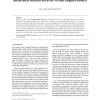Free Online Productivity Tools
i2Speak
i2Symbol
i2OCR
iTex2Img
iWeb2Print
iWeb2Shot
i2Type
iPdf2Split
iPdf2Merge
i2Bopomofo
i2Arabic
i2Style
i2Image
i2PDF
iLatex2Rtf
Sci2ools
115
Voted
CGF
2010
2010
Hierarchical Structure Recovery of Point-Sampled Surfaces
We focus on the class of regular models defined by Várady et al. for reverse engineering purposes. Given a 3D surface M represented through a dense set of points, we present a novel algorithm that converts M to a hierarchical representation HM. In HM, the surface is encoded through patches of various shape and size, which form a hierarchical atlas. If M belongs to the class of regular models, then HM captures the most significant features of M at all the levels of detail. In this case, we show that HM can be exploited to interactively select regions of interest on M and intuitively re-design the model. Furthermore, HM intrinsically encodes a hierarchy of useful segmentations of M. We present a simple though efficient approach to extract and optimise such segmentations, and we show how they can be used to approximate the input point sets through idealised manifold meshes. Categories and Subject Descriptors (according to ACM CCS): Hierarchical clustering, segmentation, shape primiti...
| Added | 13 Jan 2011 |
| Updated | 13 Jan 2011 |
| Type | Journal |
| Year | 2010 |
| Where | CGF |
| Authors | Marco Attene, Giuseppe Patanè |
Comments (0)

